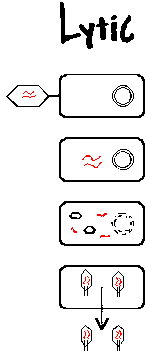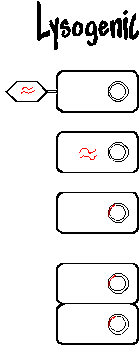Cycles of Viruses
Viruses undergo cycles of replication once they have infected a host cell. There are two types of replication, the lytic and lysogenic cylces. Although they are different, viral replication can involve both methods in separate phases or interchange between the two under certain environmental pressures.
To contrast, in the lytic cycle viral DNA destroys cell DNA, takes over cell functions and destroys the cell; in lysogenic cycle, viral DNA merges with cell DNA and does not destroy the cell.
In lytic cycle, the virus replicates and produces progenies; in lysogenic cycle the virus does not produce progeny.
In lytic cycle, there are viral symptoms as a result of infection; in lysogenic cycle there are no viral symptoms.
In lytic cycle, virulent viral infection occurs; in lysogenic cycle, only temperate viral replication takes place through cell division.
In lytic cycle, the virus replicates and produces progenies; in lysogenic cycle the virus does not produce progeny.
In lytic cycle, there are viral symptoms as a result of infection; in lysogenic cycle there are no viral symptoms.
In lytic cycle, virulent viral infection occurs; in lysogenic cycle, only temperate viral replication takes place through cell division.


